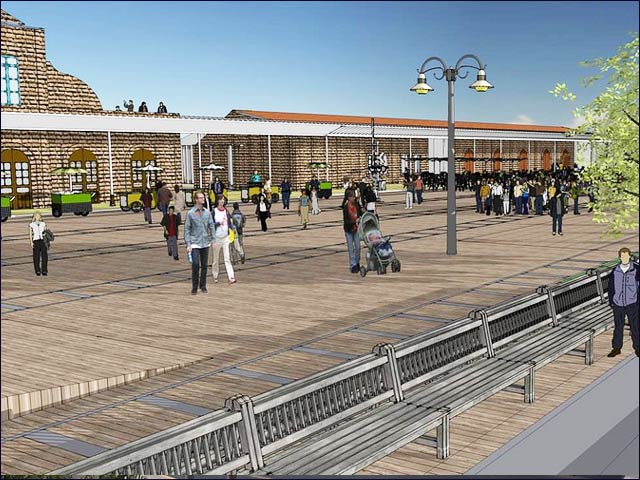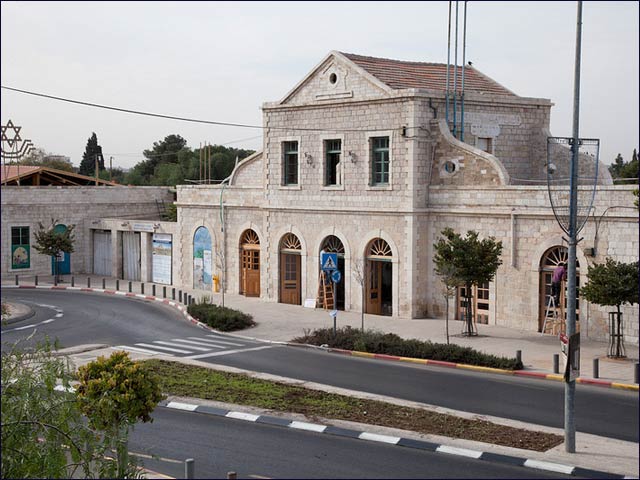By Avigayil Kadesh
Black-and-white photos of late 19th century gentry passing through Jerusalem’s Old Train Station hang on the unfinished brick walls of an upstairs room at the abandoned station house, where the Jerusalem Development Authority (JDA) gave a recent press tour kicking off the planned reconstruction of the iconic building.
Rebranded “The First Station,” the 130-year-old structure will not make practical use of the railroad tracks that still lie in disrepair in the large space behind the station house since the last train rolled through in 1998.
Not meant to revert to its previous life, The First Station instead will be a center for dining and leisure as well as musical, literary and artistic events. Historical touches are to include those old photos and an outdoor exhibit of vintage locomotives, according to project spokeswoman Gili Katz.
Though the building is dilapidated, the location couldn’t be better. The First Station sits on a premium piece of real estate at the crossroads of the upscale neighborhoods of the German Colony, Baka and Abu Tor, across David Remez Square from the Khan Theater and down the road from the Jerusalem Cinemateque and the Menachem Begin Heritage Center. In addition, the Jerusalem Theater is not far away and the Sherover Cultural Center is now being built in Abu Tor.
“This is a national preservation site that has been neglected for years,” JDA Deputy CEO Anat Tzur told Haaretz. “It was not fitting, neither from a historical perspective nor for a capital city, for such a special place to look like that.”
Preserving the old train station feel
A complex offering shopping, dining, culture and nightlife options in this area makes good business sense, though various attempts over the years have fallen flat.
Due to open on May 14, 2013, The First Station will encompass exhibition and performance spaces, outdoor vendor carts and an assortment of eateries and gourmet restaurants.

Artist’s rendering of the future complexThe NIS 35 million ($9.3 million) project is financed by private investors, the municipality and business owners. In order to attract as wide a public as possible it will be open on Saturday (the Sabbath) – an unusual and controversial move for a venue in the Holy City.
Katz stresses that this is part of Mayor Nir Barkat’s vision of making Jerusalem an attractive place not just for religious populations but also for non-religious residents and tourists. The nearby Cinemateque is also open on Saturday.
“The mayor made this decision a long time ago after considering all sides, and he does not want to hurt or offend anyone,” says Katz, who explains that approximately half the eateries in the new complex will be kosher and closed over the Sabbath.
“Any restaurants that are privately owned will be open, while others that are part of national chains will be closed,” she says.
The development plan also calls for a bike path that will link The First Station with Train-Track Park, a nearly completed walking and cycling promenade constructed by Israel Railways and the Jerusalem municipality.
The property was won in an Israel Railways tender by the same group of men -- Assaf Hemo, Erez Navon and Avi Morduch -- who turned Tel Aviv-Jaffa’s Hatachana, the neglected old Ottoman railway station at the opposite end of the route, into a thriving complex of cafés and restaurants, designer shops and art galleries. Both buildings were designed in classic 19th century European and Templer style using local materials.

The Old Jerusalem Train Station todayThe investment group has promised to work with preservation architects to keep intact the original façade or footprint of the old Jerusalem limestone structure. They will operate and maintain the station on the proceeds from rent and income from special events.
The agreement stipulates that after 10 years, management of the site returns to the discretion of Israel Railways, but if the project is successful it’s likely that it will continue to be run by the same group.